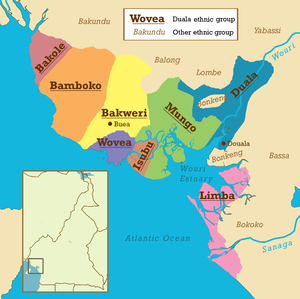Limba people (Cameroon)
Ewale moved to the mouth of the Dibamba with his followers and then northwest to the east bank of Wouri River estuary.[2] Limba territory lies southeast of the Duala, east of the Wouri estuary, to the mouth of the Sanaga River, and up its course to Edéa in the Sanaga-Maritime division of the Littoral Province.The Limba purchased goods and slaves from interior groups and sold these items to the Europeans, typically aboard their ships (and later at mainland factories or stores).In exchange, the Europeans provided alcohol, gunpowder, guns, mirrors, shoes, textiles, and tools.[4] The Limba often utilise Duala and Mokpwe as trade languages, due largely to the spread of these tongues by early missionaries.

CameroonDuala languagesBakoleMokpweWumbokoChristianancestor worshippersBakweriBambokoethnic groupRepublic of Cameroonoral historyDibamba RiverWouri RiverestuarySanaga RiverWouri estuaryLittoral ProvinceFishingslavesFrenchBritishGustav NachtigalGerman EmpireMalimbaNiger–Congotrade languagesNgondobeauty pageantspiroguewrestlingEthnic groups in CameroonAkunakunaAnglo-CameroonianBakokoBakossiBalighamBamilekeBeti-PahuinBudumaChambaKanuriYerwa KanuriKapsikiMusgumTupuriKotokoMambilaMandaraMankonWidikumWodaabe